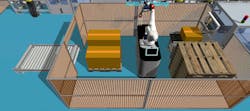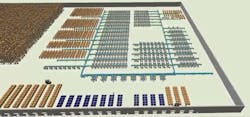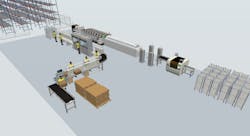How Digital Twins Can Increase Agility and Bolster Operations
It’s no secret manufacturing has been a laggard in digital transformation. In fact, more than 90% of manufacturers say that they face a variety of barriers when it comes to digital innovation. However, as organizations look to advance their operations with Industry 4.0 technology, digital twins are enabling companies to scale operations at factories across the world, detect issues sooner, visualize more outcomes and build better products.
By mapping out a complete virtualized footprint of factories, product lines and hardware, digital twins can provide significant efficiencies for organizations. To observe these outcomes, leaders must understand the basics of digital twins, how simulation feeds a digital twin, and the barriers to implementing the technology at scale.
The Basics of Digital Twins
To start, it's essential to understand what a digital twin encompasses. As the name suggests, a digital twin is an exact replica (or “twin”) of a real-world asset that bridges the connection between the physical world and its virtual counterpart in real time.
While digital twins have evolved rapidly over the past decade, the idea of modeling the physical world has been around for decades. The emergence of electronics brought the proposed concept of simulation, which has developed over time into a powerful tool for operational decision-making.
READ MORE - From Drafter to Innovator: The Evolution of the Design Engineer
But simulation and digital twins are not the same thing – and understanding the difference is critical.
Simulation vs. Digital Twins
Every environment in the world is made up of three elements: space, time and matter. The matter can be any of the physical “stuff” in that environment. In a factory, for example, this would be the boxes, machines, materials, people, and more. A simulation is created by going into these physical spaces and modeling the elements of its environment the exact same way in a digital space. This model provides a basic concept of what’s happening in the physical environment.
While simulation and digital twins both use virtual model-based simulations to replicate a system’s various processes, a digital twin is an expansive virtual environment, made up of a composition of technologies that develop a real-time link between physical and digital worlds.
Digital twins take simulation models a step further to replicate more complex assets or processes that interact with several components. Digital twins include other factors that simulation leaves out, like IT systems, finance programs, variables like humidity and temperature of an environment, people and physical features like pipes and walls and much more.
Digital twins use sensors attached to real-world assets to collect, communicate, analyze and use real-time data that drives intelligent action. This continuous synchronization loop from the physical world to the digital world and back to the physical world is unlocking huge potential for even more precise and accurate modelling. With the rapid rise and accelerated adoption of digital twins, leaders in tech are working to create a more connected future, and innovation in this space is just beginning.
WATCH MORE: Condition Monitoring in the Age of Industry 4.0
Why Companies Should Focus on Digitization
Factories are built with highly complex pieces of machinery that constantly interact with one another and company-wide systems. This complexity makes it difficult to understand how to drive improvements at a production site, and the impact changes have up and downstream. Traditionally, making any change at a factory was a cumbersome, time-consuming, and high-cost endeavor. It requires physically moving equipment, people, and lines to test and see if tweaks create meaningful increases in throughput and improvement in operations.
With the use of digital twins, companies can test out updated equipment or product configurations in a virtual environment that allows for change and optimization without the need for any physical factory involvement. This, in turn, can make potential problems much more visible before having to go through a lengthy trial-and-error process and, therefore, lowering the risk of costly miscalculations and lost time.
Without simulation, this testing process can take several months to complete. Medical device manufacturing, for example, can take years, given the high stakes of a patient’s well-being and the need for precise planning and forecasting. In one instance, manufacturing technology company Flex was able to create a digital twin of the factory floor and successfully accelerate and optimize the development of a Class II diabetes product in only three weeks' time.
Lessons Learned from Digital Twin Implementation
In theory, digital twin technologies hold sheer unlimited promise and can fundamentally change industries. But a successful digital twin project needs to be about more than just providing a technological capability – it needs to align with business objectives and provide a measurable impact on top- and bottom-lines.
Therefore, it's critical that digital twin deployments fit into existing workflows and operations of a business. A digital twin does not exist in a separate realm all by itself. It is part of an ecosystem connected to existing processes, data and technology.
Moreover, good data is the basis of reliable digital twin solutions, and turning massive amounts of data into functional, real-time digital twin simulations means engaging in some serious streamlining, a task that machine learning and artificial intelligence have been working on for quite a while.
While digital twins have the potential to help drive innovation and accelerate product development, companies must be able to manage any gaps in data streams and be open to taking the necessary action to build on existing assets and processes to return real value.
A More Connected Future
Digital twins are designed to determine which input variables will make the biggest impact on specific outputs, enabling manufacturers to predict future outcomes and identify problems before they occur. There are hundreds, if not thousands, of key variables to describe the physical assets and processes within manufacturing operations.
With the right production data and information, digital twins have the potential to remove the physical restraints of production line testing, increase visibility across facilities and departments to make better decisions, faster, and solve some of manufacturing’s biggest challenges.
This article was written and contributed by Zohair Mehkri, Director of Digital Twin, Flex.
About the Author
Zohair Mehkri
Director of Digital Twin at Flex

Leaders relevant to this article:





